A well-preserved mummy of a baby woolly mammoth was found by gold mine workers in the Canadian Klondike.
This was reported on the website of the administration of the Yukon Territory, which includes the Klondike.
Prospectors discovered the frozen carcass while digging through the permafrost.
“On June 21, 2022, a mummified, almost completely preserved body of a woolly mammoth cub was found
in the Klondike gold mines within the traditional territory of the Tshondek-Khvechin community (the indigenous people of the Yukon.
-
RT ) .
For the community of Tshondaek-Hvaechin and the government of the Yukon Territory, this find is of great importance.
The elders of Tshondek-Khvachin named the mammoth Nun Cho Ga (Nun cho ga), which in translation from the Heng language (Tshondek-Khvachin language.
-
RT
) means "big cub," the message says.
A preliminary examination of the mummy allowed scientists to assume that it is a female.
Nun Cho Ga is about the same size as the mummy of a baby woolly mammoth named Lyuba, found in 2007 in Siberia.
The age of the Siberian find is about 42 thousand years.
As for the mummy of Nong Cho Ga, scientists from the Yukon Geological Survey and the University of Calgary suggested that it could be over 30,000 years old.
“Nong Cho Ga was the first mummified woolly mammoth to be found in North America practically intact and in the best possible condition,” the Yukon government said.
Participants of the congress of paleontologists during the examination of the baby mammoth Lyuba, found in the permafrost near Salekhard, 2007
RIA News
© Alexander Erokhin
According to Yukon Territorial government paleontologist Dr. Grant Zazula, Nung Cho Ga died during the last ice age.
Scientists managed to detect grass in the intestinal tract of the mummy.
“This gives us an idea of what she was doing in the last moments of her life,” the scientist said in a CBC commentary.
In his opinion, the situation could develop as follows: moving away from his mother to eat herbs and drink water, the mammoth got stuck in the mud, from which he could no longer get out.
“And these events — from the moment of bogging down in the mud to the burial — passed very, very quickly,” Zazula suggested.
According to him, it will take days, weeks and months to realize everything and decide together with the Tshondaek-Khvachin community what to do with this find and what it can tell.
As noted in an interview with RT, a senior researcher at the Paleontological Institute.
A. A. Borisyak RAS Evgeny Mashchenko, this is the first find of a complete mammoth mummy made in Canada.
For comparison: five such finds were made in Russia, three of which are approximately the same state of preservation as the mammoth cub found in Canada.
According to the expert, mostly paleontological finds in Canada are made in the Yukon territory, since there is permafrost in the region.
However, in Canada, the thickness of the permafrost layer is small - less than a meter.
In the north and northeast of Eurasia, in Russia, permafrost can reach many meters in depth over a long distance.
That is why well-preserved remains of large Ice Age animals such as mammoths are rare in Canada.
Recall that in December 2021, researchers from the United States and Canada came to the conclusion that wild horses and woolly mammoths that lived during the ice age in the Klondike could finally die out less than 6 thousand years ago.
This is evidenced by the data obtained as a result of the decoding of ancient DNA from local deposits.
However, scientists have not yet been able to collect accurate data on the population of mammoths living in Canada.
All information about these extinct animals was collected in Russia, where they found not only frozen mammoth cubs, but also adults, Mashchenko explained.
“Most likely, the mammoths that lived in the territory of modern Yukon were similar to those that lived in eastern Siberia.
In those days, land bridges regularly arose along which animals could move in different directions, ”the expert added.
Gettyimages.ru
©Print Collector
As the paleontologist explained, it has already been proven that mammoths from northeastern Siberia crossed to North America along the Bering Land Bridge and interbred with local species there.
Speaking about the features of the latest discovery made in the Yukon, Evgeny Mashchenko suggested that scientists have already done a tomography, since they can talk about what gender the found cub has and what internal organs are preserved.
“The fact that grass was found in the digestive tract suggests that the cub was not so small (according to Zuzula, the age of the mammoth is 30-35 days. -
RT
).
As far as is known, mammoth cubs switched completely to the diet of adults at the age of one year, ”summed up the expert.

